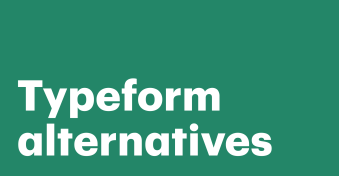Of the many online form builders on the market today, Wufoo is one of the most straightforward options for data collection and organization.
The software has everything you need to jumpstart form creation, including a range of templates, analytics and reporting tools to help keep performance on track.
But it’s not the only option out there. In this article, we’ll look at 10 great Wufoo alternatives that you should consider.
What is Wufoo?
Wufoo is form builder software that makes it easy for anyone to create, send, and record online forms and surveys.
It’s a popular choice for collecting information from dispersed teams, customers, employees, and business partners.
The service offers 400+ ready-to-use templates that can be edited within the Wufoo form builder.
Featuring an intuitive drag-and-drop interface with a variety of customization options, users can create bespoke forms in a matter of minutes.
Wufoo forms can be embedded on a website, shared via a link, or integrated with other platforms, such as payment processors, email marketing services, and social media.
In fact, the platform boasts integrations with over a hundred online services.
As a cloud service, you can access your forms and results from any device.
Data recorded on Wufoo forms is encrypted to SSL standards and stored in SOC 2, Type II data storage facilities in the USA.
As for the front end, Wufoo forms use HTTPS/TLS web encryption, protecting users from cross-site scripting (XSS) attacks.
Once you’re up and running, Wufoo offers a range of features to make data collection and analysis easier, including real-time reporting and customizable email notifications.
What is Wufoo used for?
Wufoo is a popular application for any team that needs to gather data, helping them to streamline their collection processes.
As you may expect, the service is useful for a variety of industries and applications.
Here are a few of the most compelling use cases:
- Event registration: Wufoo can be used to collect information and manage registrations for events such as conferences, workshops, and seminars.
- Customer feedback: Businesses can use Wufoo to gather feedback from customers, including product feedback, satisfaction surveys, and post-purchase evaluations.
- Market research: Researchers and market analysts can use Wufoo to conduct surveys and gather data on consumer behavior, market trends, and other relevant information.
- Job applications: Wufoo can be used by HR departments and recruiters to collect job applications and resume information from potential candidates.
- Lead generation: Sales and marketing teams can use Wufoo to capture leads and gather information about potential customers, inviting them into their sales funnels.
- Internal data collection: Wufoo can be used to collect data on a variety of topics, including employee engagement, project progress, and budget tracking.
How we found and selected our top Wufoo alternatives
Wufoo certainly has no shortage of competitors if you’re shopping around for form -building software.
In order to accurately select and assess all the form options on the market, we analyzed reviews, feedback, and criticism from over two dozen different websites and weighted what we saw based on website views and perceived authority.
To determine authority, our data sources were grouped into five cohorts based on monthly visitors (which we took from Semrush):
- >1.000.000 visitors;
- 500.000 – 1.000.000 visitors;
- 250.000 – 500.000 visitors;
- 50.000 – 250.000 visitors;
- <50.000 visitors.
The websites with the highest visitor traffic and greatest domain authority were given more weight in our calculations and analysis while lower-traffic web and less authoritative websites were scored lower.
However, in-depth reviews and feedback were given considerable analysis and weighed carefully as part of our calculation, too.
On top of all that, our company also offers PandaDoc Forms, a competitive form builder that is a perfect fit for users looking for all-in-one form creation.
As you can imagine, our team conducted extensive market research in order to create a product that felt right at home among competitors!
We closely reviewed a variety of websites — including several not listed in our final selection — in order to determine the best form builder solutions according to what features were offered, and which software tools were the closest fit to what we believe users interested in switching might look for.
Lastly, we also checked with our team and customers to better understand how businesses actually use these tools, what features they were interested in, and which are the most beneficial from their point of view.
Top Wufoo alternatives: Free and paid
Now that we’ve explained our methodology, it’s time for us to cover our top ten picks for the best Wufoo alternatives.
Our selection includes a variety of form builder programs, from budget starter apps to enterprise-level services.
You should have no issues with finding the perfect alternative to Wufoo for your personal, professional, or business needs.
01. Formstack Forms

Pricing: Plans start at $50/month when billed annually; free trial available.
One of the most formidable Wufoo competitors on our list, Formstack Forms (formerly WebMerge) is part of the Formstack family of apps.
Overall, it offers very similar features to Wufoo, including a robust template library and many of the same tools, albeit at a more expensive price point.
The power behind Formstack Forms comes from using the entire Formstack platform, which includes solutions for document generation, electronic signatures, and more.
Without that complete solution, Formstack may lack some of Wufoo’s appeal simply due to cost.
Pros
As part of a complete document solution, Formstack makes more sense. If you want Formstack to handle form and document preparation, folding everything into a single platform might be ideal.
On the surface, Formstack looks like it offers more robust features than Wufoo. In some cases, this is true.
Formstack has more native integration options than Wufoo, but both tools connect to Zapier, so you’ll see similar overlaps there.
One of the key integrations to note is Formstack’s WordPress integration. Like Wufoo for WordPress, Formstack allows you to embed forms into your website through a simple plugin. No HTML/CSS coding required.
Cons
Compared to Wufoo pricing (and to some other Formstack alternatives), Formstack is much more expensive.
Even to access features like HIPAA compliance, which would be a key differentiator between these two platforms, you’d need to pay enterprise-level pricing, which is more expensive than the Platinum plan ($225/month when billed annually).
While Formstack can help you create great forms and workflows, it might also take a hefty bite out of your budget.
02. PandaDoc Forms

Pricing: Plans start at $49/month billed annually; free trial available.
One of the newest Wufoo alternatives on the market, PandaDoc Forms is a powerful way to create incredible forms.
Available on our Business and Enterprise plans, PandaDoc Forms allows you to create basic forms, embed them on your website, capture credit card payments and electronic signatures with form submissions, and more.
On top of form creation (covered in our detailed comparison article, PandaDoc vs Wufoo) you’ll still be able to use all of the same great features and tools that come with your PandaDoc plan, including the ability to create powerful quotes, proposals, and contracts.
Pros
All bias aside, PandaDoc is the best alternative to Wufoo for a few reasons. For PandaDoc users, forms are a no-cost addition to the other great document creation options that we have on offer.
This means that, when using PandaDoc, you’ll always have the right tool for the job.
The downside to using Wufoo or any of the other competitors on our list is that they’ll only help you create forms.
PandaDoc users can create any type of business document and send it to partners for review.
One major area where PandaDoc excels is in security and compliance. Wufoo doesn’t offer any kind of HIPAA compliance, and data security and encryption tools are only available on higher-tier plans.
PandaDoc is serious about security, and all data on our platform adheres to HIPAA laws, GDPR regulations, and SOC Type 2 standards — all at no extra charge.
Cons
The downside to using PandaDoc Forms is that it’s a newer software option.
Compared to other Wufoo alternatives, PandaDoc Forms currently lacks some of the functionality that you’d need to create robust and complex multi-page forms.
If you’re looking for the ability to use conditional logic, skip logic, or perform advanced calculations in your forms, PandaDoc might not be the right fit — although this is likely to change in the near future as our teams continue to add additional features and functionality to the platform.
03. Jotform
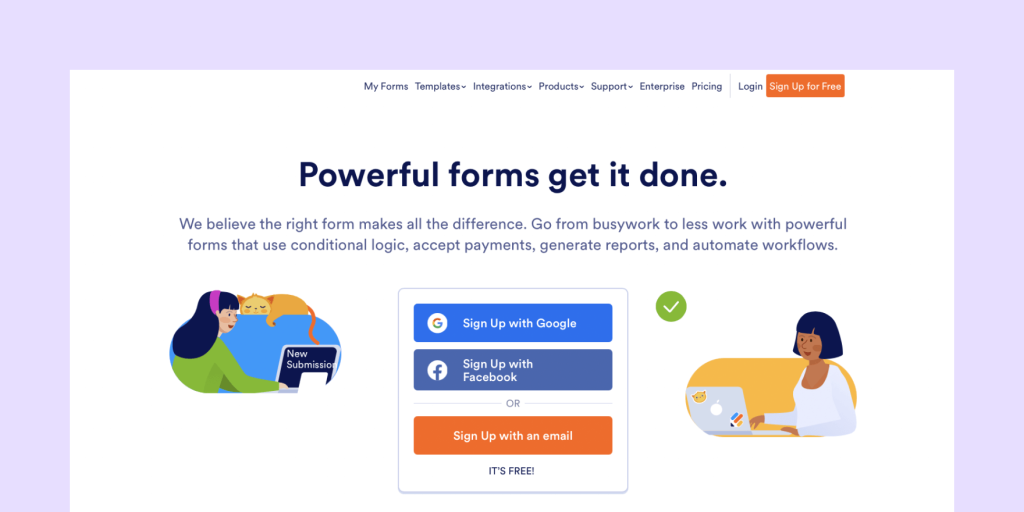
Pricing: Plans start at $34/month billed annually; free plan available.
Trusted by over nine million users, Jotform is one of the most popular Wufoo alternatives.
Using the template library and simple drag-and-drop tools, you can create everything from contact forms to online surveys in minutes.
Jotform’s pricing structure is competitive with Wufoo at lower levels and actually offers better options at higher tiers, where file uploads and user forms may play a key role in scaling out your marketing automation toolkit.
Pros
Jotform gives you everything you need to create conversational forms that work for your business.
Like Wufoo, the platform comes with conditional logic and is loaded for bear with templates and quick-build solutions so that you can build forms with ease.
On the Enterprise plan, you’ll receive unlimited upload space, which is huge, compared with what you’ll receive with Wufoo.
Not to mention the unlimited submission storage, meaning you never have to worry about responses being deleted from your workspace.
Cons
There are some downsides to Jotform, particularly in lower pricing tiers.
At all levels, Jotform limits the number of monthly form views, meaning that if you plan to place the form on your website, you’ll have to factor for an estimated view count — even if those viewers don’t complete the form.
So far, Jotform is the only Wufoo alternative we’ve seen that counts views, so it’s something to keep in mind.
On the higher-tier plans, Wufoo allows double the monthly submissions when compared to Jotform, but Wufoo comes with a larger price tag.
Plus, as with some of the others on this list, HIPAA compliance is only available with one of the higher tiers – Gold, at $99/month.
04. Cognito Forms
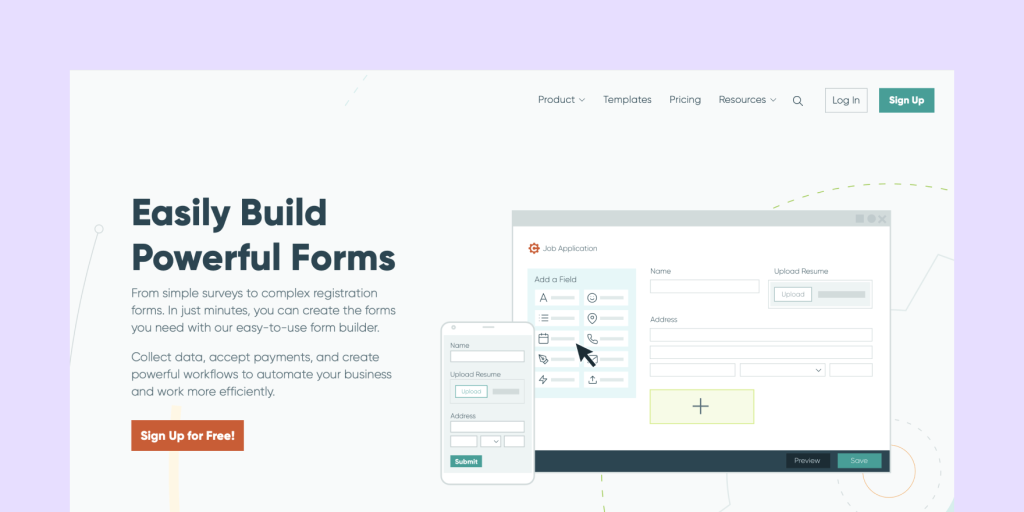
Pricing: Plans start at $15/month; free plan available.
If you’re looking for forms that go beyond conditional logic and basic form fields, Cognito Forms might be for you.
Compared to Wufoo and most competitors, Cognito Forms goes out of its way to offer powerful form logic and field alternatives that you don’t often see in its competitors.
From rating scales to repeating sections and lookup fields, Cognito Forms will give you everything you need and more to build forms that align with your ideal workflow.
This software is one of the best Wufoo competitors for users who want to dig in and create forms that, while complex, could streamline the user experience.
Pros
From electronic signatures to Stripe and Paypal payment gateways, Cognito Forms has everything you need to build great forms.
The free plan allows you to create unlimited forms and capture 500 entries per month, which makes it one of the best free Wufoo alternatives, and the pricing is even better than Wufoo at scale.
At the highest tier, Cognito Forms offers unlimited monthly entries and form creation and five times the amount of storage that you’ll get through Wufoo.
Cons
Wufoo is spotty when it comes to native integrations.
It has a few, like a native Salesforce integration, but relies on Zapier to capture CRM tools and payment gateways.
Similar to Wufoo, but with even fewer native apps, Cognito Forms relies entirely on Zapier to connect to the outside world.
Another thing that may affect your ease of use: you won’t be able to access the API for direct calls, but you can use webhooks to embed forms in websites or use tools like the WordPress plugin for a no-code website solution.
05. 123 Form Builder
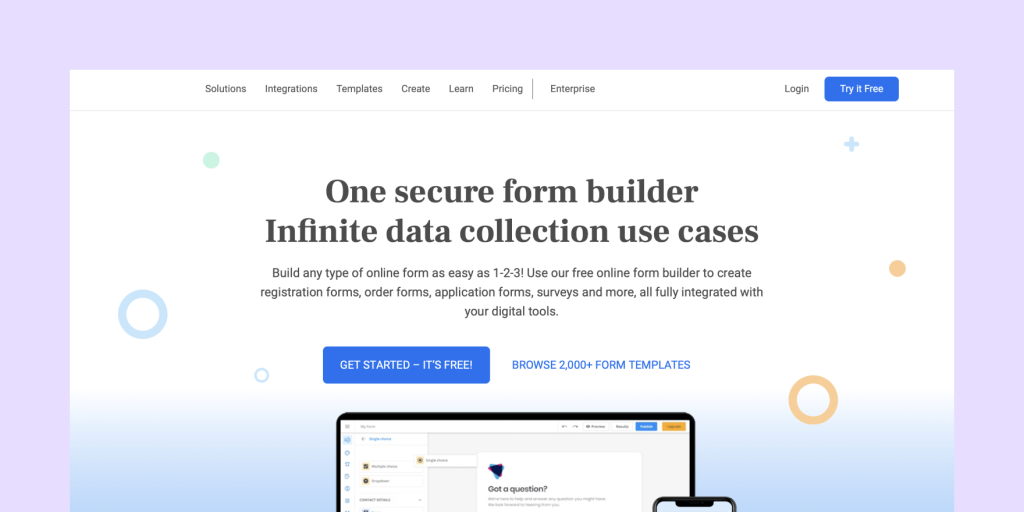
Pricing: Plans start at $19.99/month billed annually; free plan available.
One of the things we like most about 123 Form Builder is its submission limits
As with Wufoo and other competitors, you’ll still have to take submission limits into account.
However, 123 Form Builder’s submission limits are pretty generous.
The free plan provides access to 100 monthly submissions, and that jumps up to 1000 on the Gold Plan, 20,000 on Platinum, and 100,000 on Diamond. There’s no limit for enterprises.
Pros
It’s easy to build forms using 123 Form Builder.
Like Wufoo, some nice-to-have features like custom branding and encryption are only available on higher-tier plans, but you’ll never have to worry about submission limits.
Cons
Even on the $69.99 per month Diamond Plan, 123 Form Builder imposes a storage limit of 10GB
If you’re a large- or enterprise-level organization, 10GB of storage might not be enough to meet your requirements.
With 123 Form Builder, then, you will have to go for the top price Enterprise Plan.
123 Form Builder might fall flat based on that limitation alone.
06. Google Forms
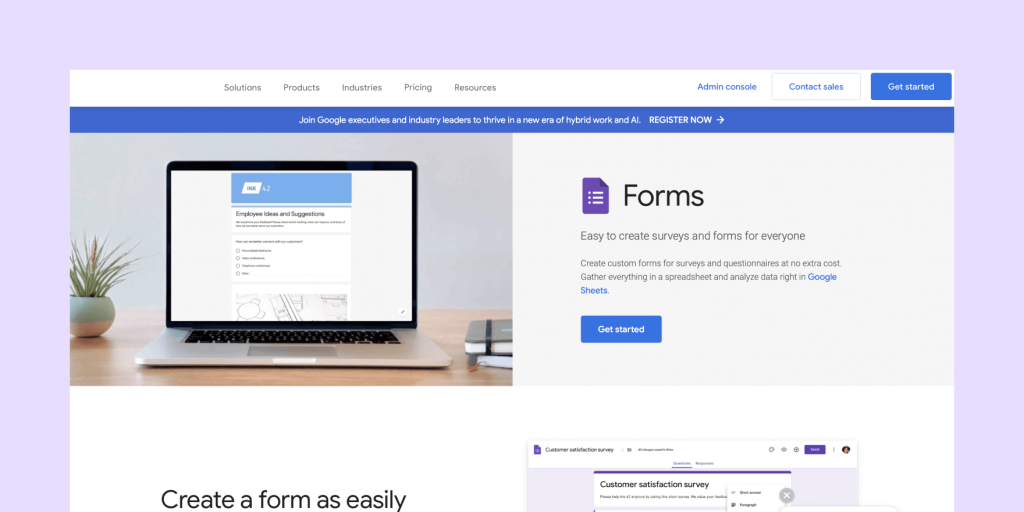
Pricing: Plans start at $6/month; free plans available.
Looking for a huge amount of customization and flexibility for little to no cost?
If you have a Google account, Google Forms might be the best option for you.
This free tool can help you capture responses quickly, easily, and at no charge—it’s no surprise it’s popular with individuals making quizzes or basic questionnaires!
As an added bonus, Google Forms is networked with a ton of other Google productivity tools like Sheets, Docs, and Slides, so you’ll always have the software you need to make sense of your data.
Pros
The Google toolset is extremely powerful in the right hands.
Google Forms can function as survey software and a form builder, allowing you to create user response layouts that make sense for your business.
While Google does offer paid plans, this is really for Google Workspace (formerly G Suite) subscribers who want to go beyond Google Drive’s basic storage limits and/or gain access to additional Google tools.
The basic functionality for Google Forms, including linking Forms to Google Analytics and other tools, won’t change.
Cons
The downside to using Google is that some of the convenience elements have been removed when compared to Wufoo and other competitors.
For example, while Google Forms has a user-generated template library, it may not have the customization options that you’d see in Wufoo themes, which can drastically affect the look and feel of your form.
At the same time, Google doesn’t integrate natively with third-party tools.
While you can use Zapier to connect to tools like Mailchimp or even Salesforce, the integration may not work as well as a more closely integrated platform.
07. SurveyMonkey

Pricing: Plans start at $32/month when paid annually or $99/month-to-month.
If you didn’t know, SurveyMonkey also owns Wufoo.
While we’re listing it as a top Wufoo alternative, it’s important to point out the dual ownership because of how SurveyMonkey and Wufoo operate in relationship to one another.
SurveyMonkey is designed for question-based surveys and user response capture while Wufoo is designed for data intake through forms and fields.
There is certainly some overlap.
You could use Wufoo to create basic surveys using text fields and radio buttons, but SurveyMonkey offers a greater selection of tools for organizing, storing, and accessing your data.
Pros
SurveyMonkey offers a greater selection of tools for survey completion.
This includes features like sentiment analysis, randomization options, benchmarking tools, and more.
You can also pay for access to your target market and let SurveyMonkey handle the rest.
The platform also comes with great survey templates and offers the HIPAA compliance options that are lacking in Wufoo.
At some level, these small gaps in the product are by design, as you’ll want to use the right tool for the job.
Cons
On the whole, SurveyMonkey is more expensive than Wufoo and is designed with a completely different purpose in mind.
If you’re just looking for ways to onboard clients or fill out basic forms and capture information in the process, SurveyMonkey won’t be a great fit for you.
On the other hand, if you want to reach out to customers and employees, gather performance data, and analyze it to find the best solution, SurveyMonkey offers a use case that is far more valuable than using a form builder to solicit a user response.
08. Zoho Forms

Pricing: Basic plan starts at $10/month when paid annually; free trial available.
Zoho Forms is a powerful form builder tool included in the enterprise-level Zoho Office Suite.
It offers advanced features for style and functionality, such as conditional logic, data analytics, and integration with form-based workflows.
Pros
The free trial allows you to send three forms, with a total of 200 MB of file storage.
That’s more than enough to get to grips with the program and its many features.
If you’re impressed with the trial, there are four standard paid plans to choose from: Basic, Standard, Professional, and Premium.
Alternatively, you may approach Zoho directly as custom plans are also offered on request.
The forms app is easy to use and contains all the features you would expect, including remote collaboration, website integrations, conditional notifications, data analysis, and more.
Plus, it works on mobile devices, with apps for iOS and Android, keeping all of your team members in the loop.
Zoho Forms comes included with Zoho One, making it a particularly attractive option for users of that service.
You can expect the forms interface to be familiar and simple to integrate with their 40+ business apps and tools.
Cons
The main issue with Zoho forms is that the selection of templates is rather limited.
That said, you can create and save as many custom form templates as you wish, streamlining business processes as you scale.
Some users may also find that Zoho Forms is better value when bought with the rest of Zoho Office Suite, as opposed to buying the application on its own.
Further, the storage may be limiting for you, as even the Premium plan only offers 10GB of storage—much less than many of the alternatives to Wufoo on this list.
09. WPForms
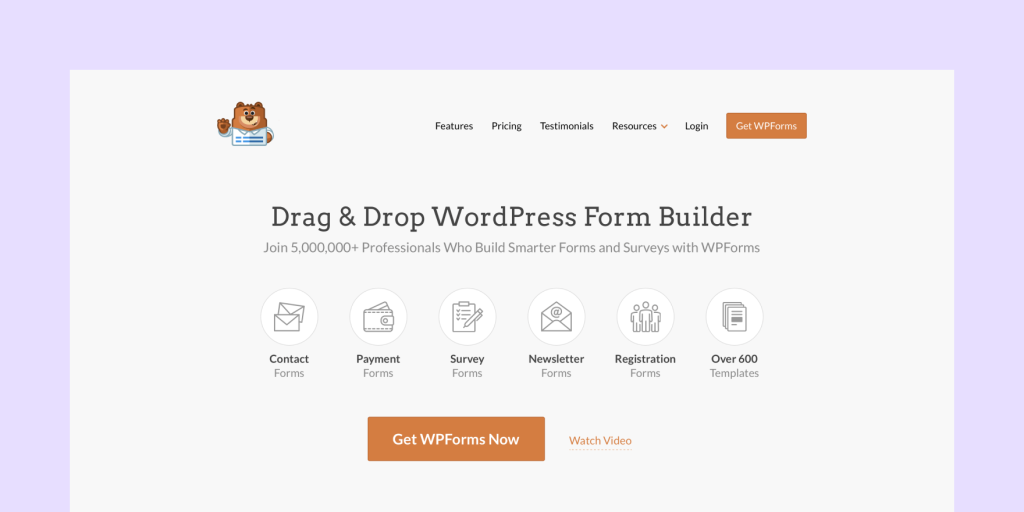
Pricing: Basic plan starts at $99/annually, although your first year is subject to a special introductory price of $49.50; 14 days money-back guarantee. Free Lite version offered.
WPForms was created specifically for the WordPress website builder. If your website runs on this content management system, look no further for the perfect plug-in.
Whether you use it for internal surveys or your site’s landing page, the web form is simple and easy to use.
Pros
The basic plan allows you to access their entire form library, create unlimited forms, and accept responses from an unlimited number of users.
The main restriction is that it can only be used on one single site. Higher-tier plans increase the number of sites you can implement it on.
Built for functionality, the forms come with some pretty nifty features, such as smart conditional logic, spam protection (Captcha), and email summaries.
And, at the Plus tier and above you get access to some great marketing integrations, including Mailchimp, while the Pro tier allows you to accept payments through major providers including Paypal and Stripe.
Cons
The major drawback of WPForms is that the free Lite plug-in is very limited in terms of functionality.
To start with, it won’t let you access common functions like telephone fields, payment fields, signatures, or file uploads.
And, as we mentioned, you are restricted by the number of websites you can use.
This means it’s great for individuals, but may be more challenging for larger businesses.
10. Microsoft Forms
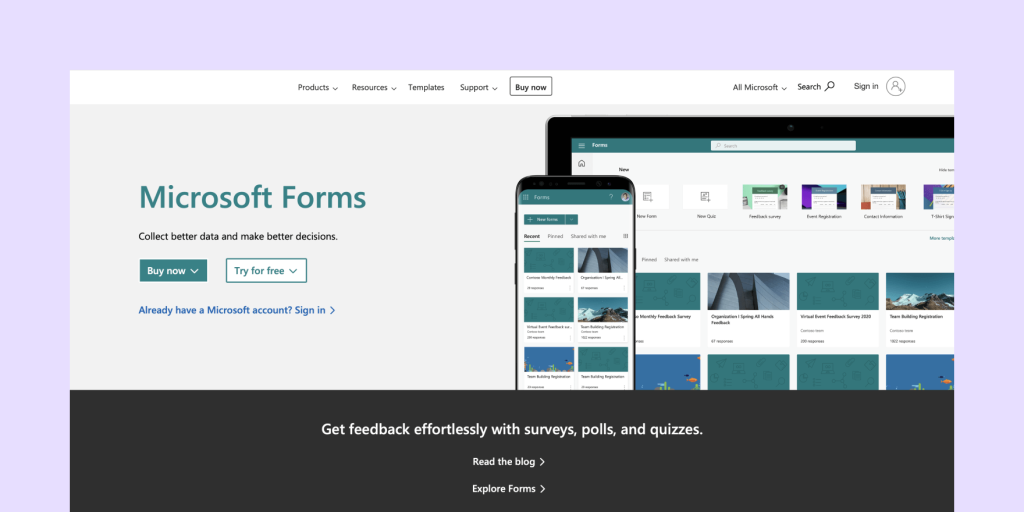
Pricing: Free version offered for personal use with any Microsoft account.
Full version included with Microsoft 365 for Business and Education. Plans start at $6/month, per user.
Looking for a cheap but reliable form generator that your team can easily get to grips with?
Well, Microsoft’s multi-purpose form generator is a strong contender for businesses that already use the Office 365 platform.
Pros
Microsoft Forms is best suited for use within the Office 365 suite.
International teams (especially budget-conscious small businesses or non-profits) may find its availability in 86+ languages to be an especially strong selling point.
Beyond that, the app itself is extremely simple to use, featuring a drag-and-drop interface for customizing forms.
Your teams will no doubt enjoy its simple integration with Microsoft’s other products, such as MS Word, PowerPoint, Excel, and Outlook.
Cons
In terms of functionality, Microsoft Forms is a rather basic program.
The app comes with just 12 pre-built template types, limiting your choice from the offset.
Whilst you can change the visual theme of these, you won’t have access to advanced features like file uploads, conditional logic, and integrations with third-party apps.
The best things in life don’t come for free, and Microsoft Forms is no exception to the rule.
In order to use them on a larger scale, you need either a Microsoft 365 Business or Education subscription.
And if you have no need for this, their Forms app doesn’t offer enough functionality to be a particularly attractive option.
Build better documents with PandaDoc
With these strong alternatives to Wufoo to choose from, you should have no problem building incredible forms for your business.
And don’t get us wrong,: as Wufoo reviews are quick to point out, it’s an amazing software tool for the right user.
However, if you need to go beyond form creation, PandaDoc may be a better fit.
Our platform can help you create every kind of sales document, from proposals to contracts at lightning speed.
Learn more about forms and other document creation options by signing up for a free 14-day trial on our Business plan.
Frequently asked questions about Wufoo alternatives
-
No, and this is one of the biggest reasons that customers seem to leave Wufoo behind. SurveyMonkey, Wufoo’s parent company, offers HIPAA compliance through the SurveyMonkey platform.
If you’re looking for proven HIPAA compliance, PandaDoc is proud to offer this feature for all documents — including forms. A Business Associate’s Agreement (BAA) is required, and the submission process is fast and easy.
-
Yes, Wufoo is a well-established brand with a long history of creating forms and surveys of all types. The company was founded in 2006 and is currently owned by Momentive Inc., which also owns the SurveyMonkey platform.
Though Wufoo doesn’t offer HIPAA compliance for its forms, the platform is generally considered safe to use for capturing and storing any non-critical or protected information. It’s a great fit for small businesses, sales teams, and any user who just needs to capture basic information about clients or potential prospects.
-
While Wufoo is mostly focused on form creation, SurveyMonkey offers a set of tools centered around longer and more robust surveys. In addition to offering a free survey platform for smaller businesses, SurveyMonkey is equipped with a battery of tools to help users collect responses and validate user feedback.
While it’s easy to imagine that SurveyMonkey is just a scaled-up version of Wufoo, the reality is more complicated. SurveyMonkey is great when you’re trying to deploy survey solutions at scale, while Wufoo is more focused on data and payment collection through simplified online forms.
-
There are plenty! SurveyMonkey is a great option if you want to stay in the Wufoo/SurveyMonkey family. Other great platforms out there that you can explore at no charge include:
-
- Google Forms
-
- Cognito Forms
-
- Jotform
-
- 123 Form Builder
-
- Zoho Forms
Keep in mind that some of the free plans may be limited while other free platforms (like Google Forms) lack all of the tools necessary to get the job done.
-
-
In our opinion, PandaDoc Forms is the way to go simply because it’s an all-in-one document tool on the PandaDoc platform. Rather than having multiple document creation tools for contracts, invoices, etc., PandaDoc users can generate all documents using one tool and drastically streamline the document creation workflow.
If you’re just looking for forms and don’t feel like the other document creation option that we offer would be helpful to you, the best alternative really comes down to user preference. Cognito Forms is probably the most technically capable, but a lot of users like the simplicity that you’ll see with options like Microsoft Forms or 123 Form Builder.
Disclaimer
PandaDoc is not a law firm, or a substitute for an attorney or law firm. This page is not intended to and does not provide legal advice. Should you have legal questions on the validity of e-signatures or digital signatures and the enforceability thereof, please consult with an attorney or law firm. Use of PandaDocs services are governed by our Terms of Use and Privacy Policy.
Originally published March 4, 2021, updated April 14, 2023

